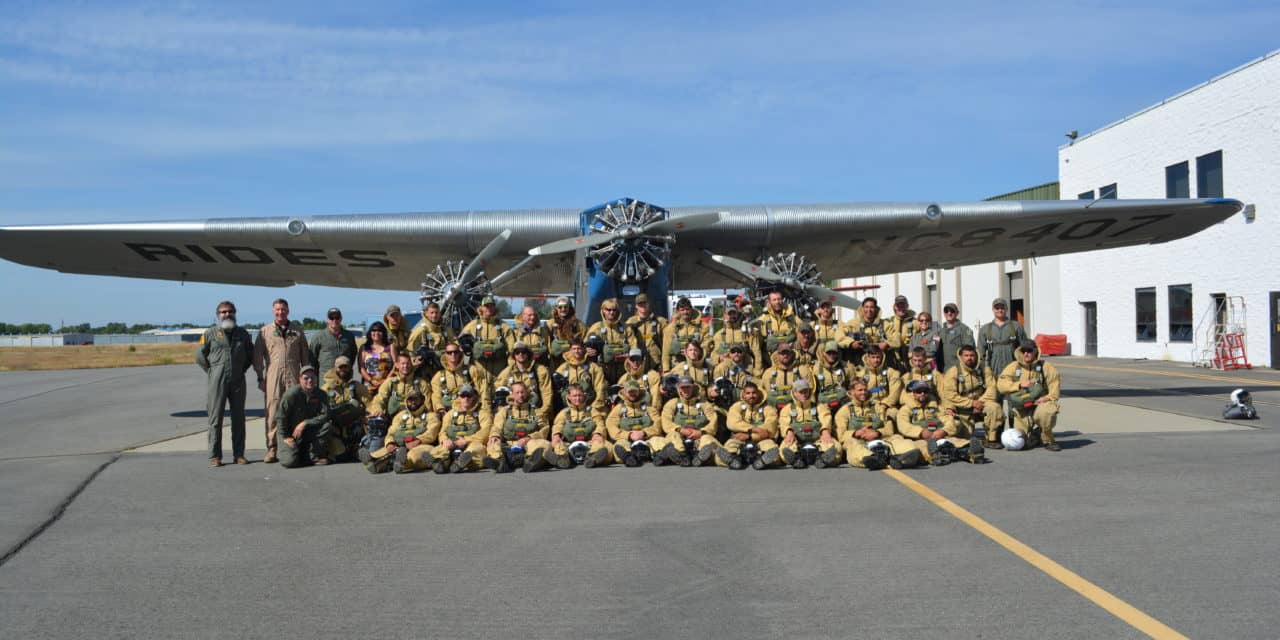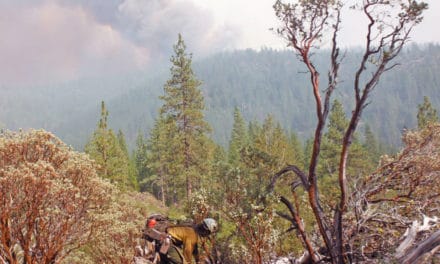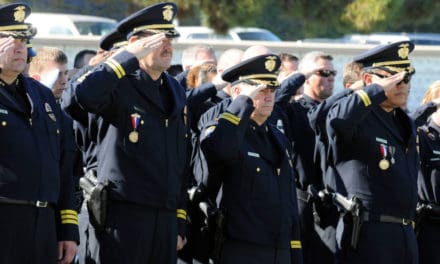Smokejumpers – The Stars Behind The Smoke
Story By Mara Dobyns
Photos by: Annette E. Moore of USFS, Kyle Jackson, and Paul Bailey
It’s summertime, it’s hot, it’s dry, and it’s fire season. Most people picture their summer like a vacation with the idea that summer should be filled with lemonade, family barbecues held lake or poolside, outdoor adventures, boating, relaxing, and just generally taking it easy while soaking up the sunshine. And it should be but for firefighters everywhere summer means something else entirely.
It’s summertime, it’s well over one hundred degrees, you’re wearing a full body suit, packing around 110 pounds or more in gear, you don’t shower, there’s no wifi and sometimes there’s not even cell service, you don’t sleep much and when you do it’s in the dirt. This is the hard reality of summer for smokejumpers.
A smokejumper is a wildland firefighter who parachutes into remote areas to fight wildfire. They can work up to fourteen days nonstop or longer depending on the severity of fire conditions. Josh Mathiesen, Smokejumper Base Manager out of Redding California has been living this lifestyle for 22 years. I was recently given the opportunity to ask him a few questions about his profession.
Q: Why smokejumping?
A: “Smokejumping is just an extension of firefighting. I love the challenge of fighting wildland fires and when you add the challenges inherent in being aerially delivered to a fire via parachute; you really get to maximize all of your potential. We often have limited resources and we are required to do more with very little assistance. As a smokejumper, I feel like I am doing something important and I feel like I am making a difference. For me, I enjoy the travel involved with the job; I enjoy the outdoors and solitude of the wilderness areas that we visit.
I enjoy not knowing where I am going to end up at the end of the day. Will I be on a fire in the Trinity Alps, or will I be in Idaho? Or maybe, I am going to get off at 6 and I get to spend time with my family. You just never know and that is often the best and worst part of the job.”
Q: Is there anything you wish more people knew about the job?
A:”I wish people realized how unglamorous this job really is. The parachuting might be the only glamorous part, but that’s about two minutes. Once you are on the ground it just becomes dirty, hard work. Great scenery, but dirty hard work nonetheless.”
Q: How much training goes into this for you?
A: “I go through refresher training every year which lasts about two weeks. This training covers both firefighting and parachuting skills. In addition to that, I spend about four weeks every year refreshing on other skills that I have to maintain currency. Physical training is a year around process, and I generally train about an hour and a half, six days a week. New smokejumpers go through about six weeks of intensive training before they are able to jump fires. In addition to this, we do a lot of short training sessions (30 minutes or less) throughout the summer. These short training sessions are usually used to brush up on medical skills.”
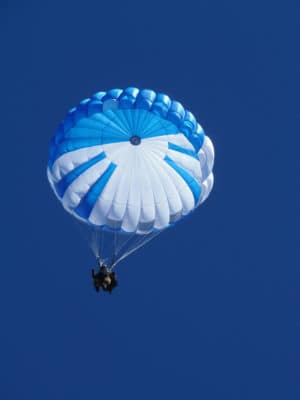
Q: What does a typical busy day in the summer look like for a smokejumper?
A: “A typical busy day in the summer is very fast paced. We are alerted to a jump request by two blasts of a horn. And during a busy day, the horn can go off all day long. We can have jump ships flying in different directions simultaneously covering a large part of the state. For example, this summer we had a load of smokejumpers flying to a new start by Lake Tahoe, and we had another jump ship flying up by Crescent City. We had a third working in Southern California on standby. When it is busy, we tend to run out of jumpers rather quick, and at that point we end up ordering boosters to help us out. These boosters come from all over the lower 48 and Alaska. In 2008, we had over 147 smokejumpers working out of Redding. As you can imagine with that many people being supported by multiple smokejumper aircraft, there are a lot of moving parts and the potential for something to be missed increases greatly. Part of my job, when it gets this busy is to step back a little, and take in the big picture looking for things that don’t seem right. I talk to my jumpers to determine their level of fatigue, and gain overall situational awareness so that I can make good decisions.”
Q: How many people are on your crew? Can you explain their positions to me?
A: “We have 40 smokejumpers that make up our crew. 23 of which work year around, and the rest are seasonal, usually working 6 months. Our Base is split into 3 functional areas: Operations, Training and Loft. The crew is divided to work in these three functional areas and I oversee these areas and provide guidance as necessary. The Loft deals with all the parachute related aspects of the job, including rigging, repair and construction. Operations, ensures that we are adequately staffed and logistically prepared to do our job. Training is responsible to train new smokejumpers, refresh current smokejumpers and provide coursework opportunities to maintain and develop incident command expertise.” Going more in depth Josh says, “If we are on ‘the load” then we suit up as fast as we can (usually in 5 minutes or less) get a “buddy check” which is a safety check to make sure all of our equipment is hooked up properly. After that we get on the airplane, taxi out, and fly away to the fire. From horn blast to take-off is about 15 minutes. Most of our fires are within 30 minutes of our base, and on the way to the fire the spotter will pass along information about the fire to the jumper in charge. The jumper in charge will get a map, radio frequencies, and any other important information about the fire (how big, other resources assigned, special instructions etc.). Once over the fire, we gather intelligence about the fire and look for a suitable place to jump. This is where we have a huge advantage over other firefighting resources, because we get to see the fire from the air. We can see the “big picture” and that helps us make good decisions once we are on the ground. Because once you are on the ground, everything looks different. Once a jump spot is selected, we do a “low Pass” over the jump spot at about 500 feet. This “low pass’ is intended for the jumpers in the airplane to see what kinds of hazards may be present in the jump spot (rocks, logs, fences etc.). If the spotters and jumpers like the spot, then we drop streamers to determine wind drift. Streamers are 15 foot lengths of crate paper weighted by a sand pouch at the bottom. These streamers simulate how far a 200 pound jumper would drift in the wind conditions over the fire area. We generally throw at least two sets of streamers to determine wind drift. The jumpers are carried upwind of the jump spot and released in “sticks”. If the jump spot is really small, we will use single person sticks, and if the jump spot is medium to large we will drop two or three person sticks depending on the conditions.”
“Once all of the jumpers get on the ground safely, then all of the tools and supplies are dropped via para-cargo. The airplane drops the cargo at 200 feet above ground level. This is when all of the food, water, tools, chainsaws and other supplies are dropped. Some situations even call for a temporary chainsaw mill operation, no sweat. Smokejumpers are generally self-sufficient for three days without re-supply.We carry everything we need to work the fire, sleep on the fire, and then at the end of the fire, we pack everything out.” But before that can happen they must first deal with the fire.
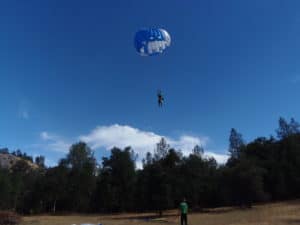
“Every fire is different. Some fires are very small (a single tree with only a little bit of ground fire) and other fires can be large. It just all depends, because we get used on all kinds of fires in a lot of different situations. Generally, we are dropped on fires that are one acre or less. And that is the whole idea of the smokejumper program; to hit the small fires hard and keep them small so that they cannot turn into costly, destructive wildfires that cost millions of dollars to fight and expose thousands of firefighters.”
“Once the jumpers are on the ground and they gather up their cargo, the whole group gets briefed and the jumper in charge lays out the plan. Most of the fires we go to follow the same chain of events. The jumpers cut a line around the fire by removing all of fuel adjacent to the fires edge and scrape away the duff layer around the edge to get a nice mineral soil perimeter. At that point, the fire can’t spread anymore. [Bold]Sometimes there will be burning trees that will fall and threaten the line and shoot embers across. Therefore, it is very important to cut down all of the burning trees as soon as possible and start reducing the heat within the fire perimeter so that there is less chance of an ember getting shot out across the line that was constructed.”
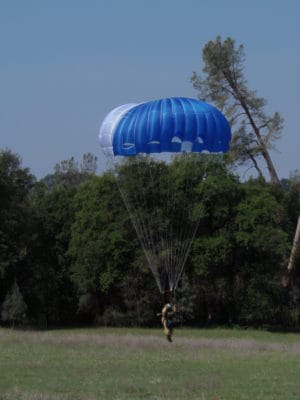
“The rest of the fire consists of mopping up, and since we hardly ever have any water to work with, mopping up is a slow tedious process and consists of stirring up the hot ash with the relatively cool dirt and continuing to do this until there is no heat or smoke left on the fire. This can take several days. Once the jumper in charge feels like the fire is out, the whole group of jumpers hand feels the entire fire and looks for any heat that may have gone unnoticed. This consists of getting down on your hands and knees and shifting your hands around in the ash to make sure there is nothing left burning. At that point, if nothing is found, the fire is called out. Then, the jumpers pack up their gear and either hike to the nearest point where they can be picked up, or sometimes, get flown off by a helicopter. Since each person has to carry over 110 pounds, a pack out can be very tough and there are occasions where a helicopter will sling the majority of our gear off in a net, which leaves us about 40 pounds of gear to hike off. Once at the pick-up point, a driver will return us to the base, and we prepare our gear to do it all over again. If there is a lot of activity, the jumpers may have only enough time to repack their gear before they jump again. We call this “jumping dirty” because there is no time for a shower and the jumpers carry the grime of the last fire with them to the next.”
In Redding they operate with two airplanes for most of the season. They have a Forest Service owned C-23A Sherpa and a Contract Dornier 228. The Sherpa can carry up to 10 smokejumpers and the Dornier fits 8. Between the two they can carry up to 18 smokejumpers at once or go in two different directions to staff fires. When the season is busy they have the option to bring in aircraft from other smokejumper bases to help out.
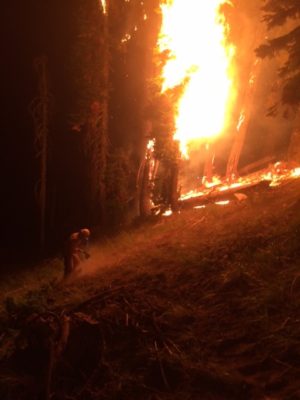
Q: What does your family think of your line of work?
A: “I honestly don’t know. I grew up in a Forest Service family, as my dad worked for the Agency. Both me and my brother are firefighters (he is a hotshot superintendent for BLM). And so for my family, including my wife who works for CAL Fire, this is pretty much all we know.”
Q: What does smokejumping mean to you?
A: “For me personally, I have never let the fact that I am a smokejumper define who I am. I honestly just look at it as a great job that I am lucky to have. I enjoy going to work, and I enjoy going home. And I have the ability to keep the two separate, which I think helps me become resilient and better able to deal with the ups and downs of the job and life in general.”
Q: On hard days or in hard moments how do you encourage yourself to keep going?
A: “I have never had a hard enough day or moment to think that I couldn’t keep going. Don’t get me wrong, I get down and frustrated; fatigued after a hard fire, but not to the point of quitting. I try to ground myself in appreciation for being able to live in this moment, and just by thinking about gratitude, it tends to put everything in perspective and chill me out. “The hardest moments for me are when my fellow smokejumpers or their families go through adversity. Whether it is a serious injury or a death in the family, this kind of thing tends to really bother me. One of our smokejumpers was killed on a fire a couple of years ago, and this really kind of rocked me. I never really thought about myself in this instance, I just remember thinking about how I wish we could go back and fix it. In these instances I tend to withdraw a little and just spend some time thinking. It always comes back to being grateful, and at that point I move on.” The saying “fueled by fire driven by courage” could never be more true. May he Rest In Peace.
Q: What do you think is one of the biggest misconceptions about smokejumpers?
A: “That we are thrill seekers and somehow more hardcore than everybody else. This is just so not true. When I tell people I am a smokejumper, they say “you’re a smokejumper? You don’t look like a smokejumper”. I am not sure what a smokejumper is supposed to look like. We definitely are a fit bunch, but not overly buffed and most smokejumpers carry a beard and shaggy hair. Smokejumping is such a mental process, and because of that, our minds may be the only thing that differentiates us from others. You can’t see the mind though.”
With so much work and little time to play Josh says he loves working around his house on his days off. “I especially enjoy working outside in the garden. A perfect day off would consist of a little work outside in the morning, and then spending the afternoon with my wife on the lake doing some stand up paddling. Then home, to barbecue and share our hopes and dreams for the future.” I wish nothing but the best for him, his family, and all wildland firefighters. A big thank you to Josh Mathiesen and all of the other brave men and women out their who risk their lives for us every day. Here’s to you.
For current fire information: http://inciweb.nwcg.gov/

